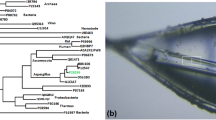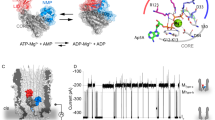Abstract
The X-ray crystal structure of the subtilisin-type enzyme proteinase K at 1.5 Å resolution1 shows that is has two binding sites for Ca2+. Scatchard analysis2 indicates that one Ca2+ binds tightly, with pK 7.6 × 10−8 M−1, and the other only weakly. Although Ca2+ is not directly involved in the catalytic mechanism and is 16.6 Å away from the α-carbon atoms of the catalytic triad Asp 39-His 69-Ser 224, the activity of proteinase K towards the synthetic substrate succinyl-Ala-Ala-Ala-p-nitroanilide drops slowly to ∼20% of its original value when it is depleted of Ca2+. This is not due to autolysis of the enzyme2. The X-ray crystal structure of Ca2+-free proteinase K shows that removal of Ca2+ from the tight binding site triggers a concerted domino-like movement of five peripheral loops and of two α-helices. At a distance of 25 Å from this calcium-binding site, the geometry of both the secondary substrate binding site and of the catalytic triad is affected by this movement thereby reducing the activity of the enzyme.
This is a preview of subscription content, access via your institution
Access options
Subscribe to this journal
Receive 51 print issues and online access
$199.00 per year
only $3.90 per issue
Buy this article
- Purchase on SpringerLink
- Instant access to full article PDF
Prices may be subject to local taxes which are calculated during checkout
Similar content being viewed by others
References
Betzel, C., Pal, G. P. & Saenger, W. Eur. J. Biochem. 178, 155–171 (1988).
Bajorath, J., Hinrichs, W. & Saenger, W. Eur. J. Biochem. 176, 441–447 (1988).
Ebeling, W. et al. Eur. J. Biochem. 47, 91–97 (1974).
Kraus, E., Kiltz, H. H. & Femfert, U. E. Hoppe-Seyler's Z. physiol. Chem. 357, 233–237 (1976).
Betzel, C., Pal, G. P., Struck, M., Jany, K. D. & Saenger, W. FEBS Lett. 197, 105–110 (1986).
Pal, G. P., Saenger, W., Bellemann, M., Wilson, K. S. & Betzel, C. Proteins 4, 157–164 (1988).
Voordouw, G., Mils, C. & Roche, R. S. Biochemistry 15, 3716–3723 (1977).
Birnbaum, E. R., Abbott, F., Gomez, J. E. & Darnoll, P. W. Archs Biochem. Biophys. 179, 469–476 (1977).
Frömmel, C. & Höhne, W. Biochim. biophys. Acta 670, 25–31 (1981).
Wells, J. A. & Estell, D. A. Trends biochem. Sci. 13, 291–295 (1988).
Bott, R. et al. J. biol. Chem. 263, 7895–7906 (1988).
Jones, T. A. J. appl. Crystallogr. 11, 268–272 (1978).
Hendrickson, W. A. & Konnert, J. H. in Biomolecular Structure, Function, Conformation and Evolution Vol. 1 (ed. Srinivasan, R.) 43–57 (Pergamon, Oxford, 1981).
Lesk, A. M. & Hardmann, K. D. Science 216, 539–540 (1982).
Author information
Authors and Affiliations
Rights and permissions
About this article
Cite this article
Bajorath, J., Raghunathan, S., Hinrichs, W. et al. Long-range structural changes in proteinase K triggered by calcium ion removal. Nature 337, 481–484 (1989). https://doi.org/10.1038/337481a0
Received:
Accepted:
Issue date:
DOI: https://doi.org/10.1038/337481a0
This article is cited by
-
High-resolution crystal structures of a “half sandwich”-type Ru(II) coordination compound bound to hen egg-white lysozyme and proteinase K
JBIC Journal of Biological Inorganic Chemistry (2020)
-
A Simple and Affordable Method of DNA Extraction from Fish Scales for Polymerase Chain Reaction
Biochemical Genetics (2013)
-
The effect of calciums on molecular motions of proteinase K
Journal of Molecular Modeling (2011)
-
Unusual clustering of carboxyl side chains in the core of iron-free ribonucleotide reductase
Nature (1993)



